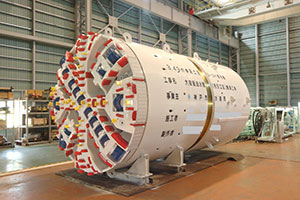120 Years of History(Water Supply)
- TOP
- 水道局の紹介
- 事業連携
- 水・インフラ整備の国際展開
- International Activities Waterworks and Sewerage
- 120 Years of History Water Supply
In 2020 (Reiwa 2), the water supply service in Kobe held the centennial anniversary of its inauguration in 1900 (Meiji 33) as Japan’s seventh modern water supply service.
Here, the history of water service projects during these 120 years is briefly introduced.
| 1867- 1893 |
From port opening to the start of waterworks construction
When Kobe Port was opened in December 1867 (Keio 3), many people were attracted to Kobe from all over the nation and industries flourished. On the other hand, cholera and other infectious diseases were prevalent due to the use of insanitary well water, which increased the motivation to construct waterworks.
|
|---|---|
| 1897- 1975 |
First construction work
Construction of the waterworks started in May 1897 (Meiji 30). All the workers were Japanese, under the management of the engineer Tojiro Sano, and in 1900 (Meiji 33), the long-awaited sluice opening ceremony was held at the Okuhirano Water Purification Plant. This was the start of the waterworks in Kobe.to supply a targeted 250,000 people.
|
| 1911- 1921 |
The first extension works
The number of households using the water service continued to increase after the start of the water supply service, which now needed new water sources. In 1911 (Meiji 44) a survey was conducted and revealed that the Sengari River, a branch of the Muko River, had a greater volume of water of better quality for use as a water source, and required lower maintenance costs than using the Yodo River. The Sengari River was designated as a new water source and started to be used.
|
| 1926- 1937 |
Conditions in the early Showa period
Owing to the boom caused by World War I, many industries were concentrated in Kobe and the population increased as a result, doubling the water demand. To cope with this rapid increase in the water demand, work to raise the height of the Sengari Reservoir Dam and to construct the Egeyama Distribution Reservoir started in 1926 (Taisho 15), increasing the maximum daily water supply volume from 97,000㎥ to 171,200㎥.
|
| 1938- 1944 |
Flood damage and war disaster
The rain started on July 3, 1938 (Show 13) and 191.4 mm had fallen by midnight on the 4th. 41.5 mm of heavy rain continued through the morning to around noon on the 5th, with the total rainfall volume reaching 460 mm. This severe rainfall resulted in serious floods, and it required almost 3 months to restore water supplies.
The shadow of the war gradually lengthened. Although a third extension works project had been undertaken in December 1941 (Showa 16) to take water from the Yodo River through the Hanshin Municipal Water Supply Association, construction work was forced to be suspended in 1944 (Showa 19) as the war grew worse day by day.
|
| 1945- 1961 |
Postwar restoration and completion of the third extension works The waterworks in Kobe were significantly damaged by air raids. Damage to the distribution pipelines, etc. resulted in an 80% leakage rate by the end of the war. Postwar restoration began with emergency measures to prevent water leaks.
The suspended third extension works were restarted in 1951 (Showa 26). The plan was to excavate 17 km of tunnel extending to Myodani-machi in Tarumi Ward and construct seven new pumping stations to cope with the rapid population increase in the Suma and Tarumi areas. All the construction work was completed by 1960 (Showa 35).
|
| 1962- 1994 |
Further development of Kobe waterworks Fourth extension works (1960-1968), fifth extension works (1967-1978), and sixth extension works (1975-1997) were then conducted successively to cope with the expansion of the city area and the increase in the water supply population. In addition, the Hokushin, Rokkosanjyo, and industrial waterworks were also improved.
In 1985 (Showa 60), the water supply network was completed across the whole city area, achieving the long-awaited “water supplies for every citizen,” 85 years after the start of the water supply service.
|
| 1995- 1999 |
Restoration after the Great Hanshin Awaji Earthquake The Great Hanshin Awaji Earthquake occurred on January 17, 1995 (Heisei 7), devastating Kobe City, and inflicting great damage on the city’s waterworks. While water supplies stopped over the whole city area, the Waterworks Bureau continued their restoration work night and day to restore the water supply at the earliest possible time in cooperation with citizens and supporting teams from other cities. On April 17, three months after the Earthquake, the emergency measures were completed across the whole city.
Learning from the earthquake, we established the “Kobe City Basic Plan for Earthquake-proof Waterworks” in July 1995 (Heisei 7) aiming to build disaster/accident-proof waterworks. The infrastructure improvement project including improvements to the large capacity water pipe and emergency reservoirs, etc. is going ahead according to plan.
|
| 2000 |
Centennial anniversary of water supply services Overcoming various problems since its establishment in 1900, the water supply service in Kobe City celebrated its centennial in 2000 (Heisei 12) with several extension work projects implemented to improve the lives of its citizens and support urban development.
On the celebration of our centennial, we conducted various commemorative projects with the participation of the citizens of Kobe, including a commemorative ceremony, a symposium to provide opportunities for the general public to find out more about water supply services and to consider at the needs of future water supply services with citizens. |
Publication of “A Hundred Year History of Kobe City Waterworks”
We have published “A Hundred Year History of Kobe City Waterworks” (B5, approx. 1,200 pages) describing the detailed history of the water supply services up to the present day. Citizens of Kobe can find this book in the public libraries in each Ward, including the central library and lifelong study centers, etc. Please take a look this book.


















